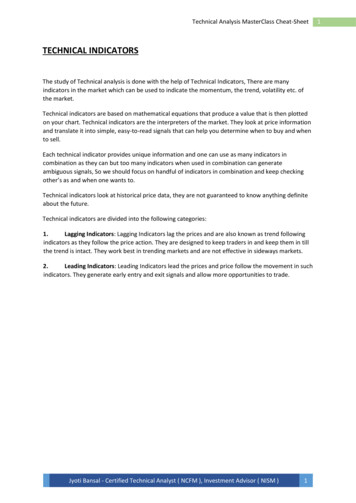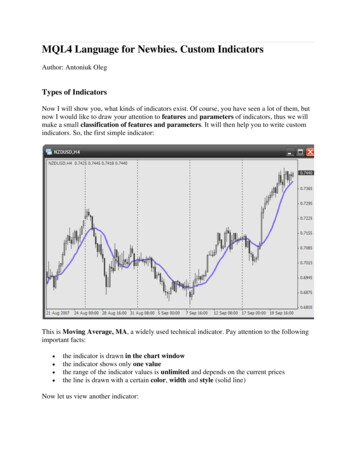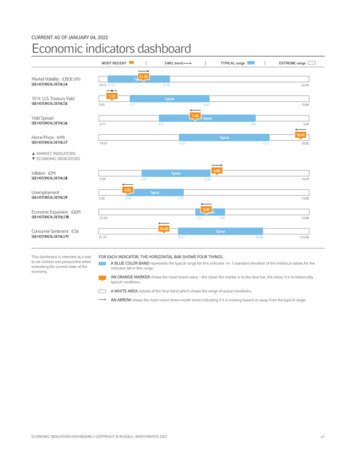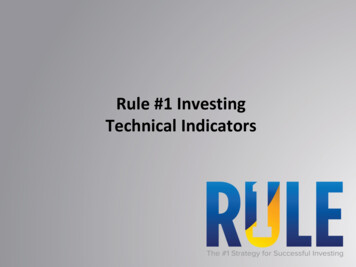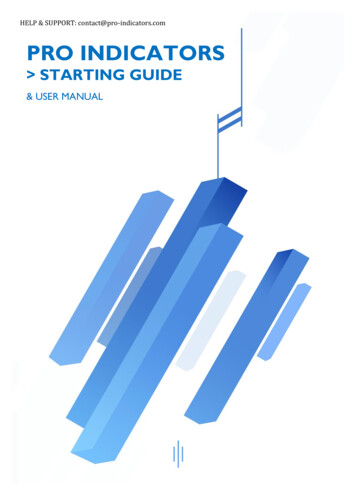
Transcription
HELP & SUPPORT: contact@pro-indicators.comPRO INDICATORS0, STARTING GUIDE& USER MANUAL
INTRODUCTIONBefore getting to the real deal, I’d like to have this little introduction. First to thank you for theinterest you have for my tools, then to present what this crazy project of PRO Indicators is, and totalk about the crazier one you’re about to get yourself into, learning about speculation !Let’s be honest, at the moment many people are gathering interest in the financial system, andvarious reasons push them toward speculation, but this is a very tricky path and people generally failfor the same errors ! Confronting yourself to the permanent doubt surrounding the market is a fightthat you’ll have against your own worst enemy, yourself.Trying to understand the market is probably the most common mistake. Facing uncertainty, you’llprobably try to fight against this feeling by desperately trying to make sense to chaos (I know causeI’ve obviously been a victim like everyone else). Trading is not about understanding chaos it’s justabout accepting it. It takes time, but fighting is just a waste of time.Uncertainty about the future in psychology is the most common source of stress humans can faceapart from the traumatic stress.Which means, even if everything goes fine with your life, the market’s uncertaintywill still be a source of irrational stress. The reason is simple, you are trying tobuild your income (therefore one of the main pillars of your life) out of themarket, which is pure chaos. Who would be crazy enough to choose a life ofperpetual uncertainty and stress? As I said, none of this is real, it's an irrationalstress that can be dealt with, if you simply accept it and fight it, instead of tryingto fight the market that is something way beyond your control. I remember myself years ago,learning as you do now, thinking that a trader would be someone who « understands » the market So I'd rather like to destroy this myth right away, I'm a trader, and I don't understand a damn thing!Moreover, it’s when I truly figured this out that it was more about letting it go that I became one.The reason why I'm starting this manual with this is because you need to understand that beyond thetechnical part of trading, there's this psychological part of trading. Definitely one of the hardestthough, as shaping your psychology to trading will take years and trying to rush will be worthless.In this manual, we will obviously deal with all about the technical part of trading, but the psychologywill mostly be left aside. Greater detail will be provided through educational programs on theYouTube channel.Before going any further, I want to warn you about another mistake, which is also an unfortunatelycommon waste of time. Searching for the perfect system, the perfect strategy, the perfect indicator.(I’ve been there, lost too much time, and so will you if go down this path.)The indicator is only a tool used to apply a strategy. Just like a doctor using tools to operate. Thescalpel is the tool that links the doctor to the patient, in trading, the indicator will only be a linkbetween the market and your strategy. Wasting time looking for the best scalpel without knowinghow to operate is stupid, isn't it? Then don't be!
CHAPTER 1 : BASICS OF STRATEGY. 4CHAPTER 2 : PRICE FILTERING . 61.PRO FRAMEWORK . 6CONTEXT CHANNEL . 6TREND CHANNEL . 7« PRICE OK » ALERTS . 7FIBONACCI RETRACEMENTS . 7BREAKOUTS . 8CONFIRMATION TRIANGLES . 8PRICE SQUEEZE ALERT . 8VOLATILITY ALERT. 92. IDENTIFY THE CONTEXT . 9a. THE RANGE . 9b. THE TREND. 12c. THE BUBBLE / THE MARKET EXCESS . 14a.b.c.d.e.f.g.h.CHAPTER 3 : THE TRADING SIGNAL . 181.CYCLES . 19The average period. 19The Sinusoid . 202. THE MOMENTUM . 20a. The Momentum line . 20f. The Trail-Lines . 213. THE DETECTION ALGORITHM . 214. SETTINGS AND CUSTOMISATION: . 25d.e.CHAPTER 4 : MONEY MANAGEMENT. 26SPECULATIVE TRADERS vs TREND TRADERS: . 261. THE DIFFERENT SIGNALS . 28g. TP (Take Profit) . 28h. Overload (grey dot) . 29i. DIV (divergences). 29j. EXIT . 31k. Overbought / Oversold (blue/red dot) . 31l. BULL / BEAR . 33m. SQUEEZE . 33n. CONTEXT . 342. DEFINE YOUR PSYCHOLOGY . 34CHAPTER 5 : RISK MANAGEMENT IN POSITION . 371.2.3.MANAGING RANGE TRADES . 37MANAGING A TREND TRADE . 38PRACTICE EXAMPLE . 40CHAPTER 6 : ALERTS . 411.2.3.4.5.PRICE FILTERING ALERTS . 41CONFIRMATION ALERTS . 42SIGNAL ALERTS . 42BUILT-IN CONTEXT ALERTS. 42BUILT-IN TRADE MANAGEMENT ALERTS . 43CHAPTER 7 : PROGRESSING STEP BY STEP . 441.2.3.4.TARGETING REALISTIC GOALS . 44CHOOSING AN ADAPTED TIMEFRAME . 44CONTROL YOUR STRATEGY . 46IMPROVE YOUR PSYCHOLOGIY . 49
CHAPTER 1 : BASICS OF STRATEGYAs a logical process, a strategy is the exact opposite of “gut trading” which is based on erraticdecision-making. Just remember what we said earlier, your income will be based on your decisions.Therefore one of the pillars of your social life in nowadays society (Okay let me guess., money is the pillar of life,are you sure about that ?). It's an interesting discussion, but we'll put philosophy aside!Strategy is what allows you to fight permanent uncertainty. This means that you will be able to sleepat night while accepting the fact that everything is technically possible. (Alright, this guy just has a Godcomplex. He thinks he controls everything and fears nothing.). Certainly not. The only thing you'll rely on is the sweetcomfort of statistics. Because even chaos will have patterns and identifying them will, just give you atiny statistical advantage that makes all the difference between trading and gambling. (Hu? I thoughttrading was more or less like gambling, but doing it better.). The gambler is the one that embrace chaos, the trader isthe one who manage to succeed throughout chaos, and that’s a big difference.In statistics, expectation is a bit like rolling a 6-sided dice. from a mathematical point of view, itcan fall on any side, and it can theoretically fall an infinite number of times on the same side in arow. However, In the reality, if you throw it a lot of times, it will inevitably fall more or less equallyon each faces! I know how little bit of comfort this may look like! But that’s all you’ll have to sleepwith. Any trade will just be chaos, but hundreds of trades won’t.A good strategy is simply a good risk management to optimize yourexpectation of statistical gain! Nothing more! Just as your dice willalways fall randomly on a single event, the market will always possiblyend up in all directions and yet in the long run, those who manage therisk will have a tiny chance to earn more than what they lose! So anystrategy that does not target this objective is simply another chimerathat often seeks to "conceptualize" the market and is only a waste oftime. (So the more the guy try to understand, the less he actually gets it. crazy concept!)That's right. because there are as many strategies as there aretraders! Some are waste of time, for the reasons mentioned above, and some will worth it. So let'sanswer the right question: what does managing risks truly means? Risk management is simply tryingto exploit the rare times in which the statistical return if asymmetric (whaaaat ?!?)It’s actually a simple notion that defines odds to go one side or another. If the mathematicalprobability of having a 6 on the dice is always the same (1/6). In reality, after rolling 10 times a 6,you are slightly less likely to make another one. by just a very tiny percentage. Just like after 100throws without making 6, the probability will slightly increase! Why? Simply because, the more weroll the dice, the more reality catches up on us and tends to lead us to an equal distribution on eachside! To sum up, in a mathematical prospective, odds remain the same on each roll, it’s chaos, but inthe reality, the more you roll the more you alter those odds. And you can actually profit from that.
I don't even think that this abstract demonstration can be enough for you to sleep tight and avoidirrational stress. That why the main goal of a strategy will be to assist in making a rational decisionthat avoids as much as possible to fall back into chaos. In our 6-sided dice experiment the statisticaldistribution was simple, but when it comes to apply that to the market, this will be a bit more tricky!Because in the dice case, the possible distribution between 6 faces is easily defined (one for eachside). In the market, there are theoretically an infinity of possible directions. (Alright. so back to chaos ?!Honestly, you're not really helping me here !).When a process seems too complex, it is often necessary to break it down into tinier bites to get aclearer picture. That's exactly what we're going to do here. In order to reduce the possibilities ofmarket movement, we will proceed as follows:1. IDENTIFY PRICE CLUSTERS(Can't you be more subjective? Because you already got me lost with the math thing before.)It may sounds stupid but in fact 80% of prices are useless. Watching them, or even worse,trading them, is a mistake. Filtering them out will be necessary to reduce the statisticaldistribution. It’s like waiting to get ten 6 in a row before starting to bet you’ll have somethingdifferent than a 6. It still doesn’t guarantee anything, but you just slightly reduced your risks.It won’t make any difference on a single roll, but it will on a thousand rolls.2. WAIT FOR A TECHNICAL SIGNALWe’re looking for price reversal areas in which prices may give us slightly better chances toreverse, we’ll go a little bit further and add another layer of risk limitation. We’ll simply study“how” prices have reached out to the interesting area. Because depending on thisparameter, we will be able to filter out favourable condition.3. DEFINE AN APPROPRIATE "MONEY MANAGEMENT"Which is nothing more than adapting the trade to the level of risk surrounding it. Becausethe better is the signal the more favourable odds you’ll have. Of course your indicators willassist you in this task to avoid any “gut” decision or any subjective analysis.4. MANAGE RISK IN POSITIONBecause getting into a trade is far from being a trader, you’ll have to learn how to manage anopened trade. This means that once you’re in position you will have to repeat steps 1 and 2to identify the conditions under which it will be necessary to act by profit taking (partial ortotal), invalidating, or a simply adjusting the stoploss. I’ll also give you guidelines to manageyour opened trader within this manual but we’ll have to set that aside and we’ll get back tothis later!Now that we’ve set the basics, we will dig into each of these "steps", whichare therefore the elements that make up the strategy. You will have to learnit as it is and eventually customize it according to your personal experience.At this point, the key element you need to remember is that we’re simplygoing to exploit statistical behaviours to balance the risk and optimize longterm profits. Chaos prevails out of single trades but not out of a hundred.
CHAPTER 2 : PRICE FILTERINGINTRODUCTIONPrice filtering is an essential step. Any good statistician will tell you that before processing any type ofdata, it will always be necessary to start with a filtering to limit "noise". This is exactly what this stepof the strategy will replicate.As I said earlier, more than 80% of the prices are "unreliable" for statistical purposes. Therefore, youmust understand that forgetting this crucial step would be a fatal mistake. So many people want torun faster when it comes to learning a strategy. I want to warn you: the one who skip this step andimmediately switches to signal reading (next step) will literally get fucked up. More than losing thestatistical advantage, skipping filtering will even turn it against you!1. PRO FRAMEWORKThe filtering process will be done by a simple graphical analysis, assisted by the tool createdspecifically to make this step semi-automated (once again you come up with complicated words! You can’t help yourselfcan’t you ?). It simply means that the indicator will guide you but you’ll still have to work a little bit! Let'sstart by analysing the components of this indicator and then we’ll talk about the “how to”. You maythink that there are too many elements. Don't worry, it’s not that complicated and most of the timeyou will pass out of the first condition!a. CONTEXT CHANNELThe context channel is the most important! He's the firstone to have a look at. It will be the basis of an essential ruleof the strategy: ALWAYS TRADING IN A CONTEXT. You haveto imagine the market as multiple layers of timeframes: m1m2-m5-m15-m30-H1-H2-H4-H8-D1-W1-M1.The context channel will be displayed by two ribbons, calledthe resistant and support contexts. Consider that prices inbetween are unintersting, as they balance bullish andbearish pressure. When reaching out to one of the contextribbon, it means that this balance is shifting. In a resistantcontext, bulls are no longer buying, and bears are looking forpotential selling opportunities. Prices outside the contextsare even more shifting the balance, and therefore shifting odds.So if you get my point, this context channel will allow you to quickly know if a specific Timeframeoffers an interesting price or not! If the price is not within or beyond the context ribbons. There isnothing to do on this timeframe. Move on to the next one! And whenever you’ll have multipleoptions the choice is simple, the lower the timeframe the more agressive the signal will be. Agressivesimply means you’ll take more risks, but you’ll also going to get a better entry price. Balancingbetween the two options will depend on your trading profile. We’ll see this in details later!
b. TREND CHANNELThe trend channel will only be useful under certaincircumstances. It‘s used to identify contexts and validateif a market is following a trend or not. Formally, what willbe more useful is the « 50% » line that is the median-lineof the channel. This line is used as an input for a secondbasic rule of the strategy:NEVER SELL THE LOWER PART OF THE CHANNELin the same way we will never buy the upper part!Respect this rule to filter a bit more accurately thepossible entry prices and ensure good positions tosell/buy.Advice: zoom in the PDF if images are too small!c. « PRICE OK » ALERTSThis label is the output of an algorithm that I added to helpreading the charts according to the strategy. It checks conditionsto see if prices are trading near an interesting area or not.Never forget that you cannot blindly trust an algorithm A quickcheck is always necessary! The thing to keep in mind is that aslong as this signal is not displayed, don’t bother yourself lookingany further! Go elsewhere!d.FIBONACCI RETRACEMENTSDespite being quite useless in trending marketstructures, they will become an absolutely necessarytool to trade ranges.They may also help reinforcing technical clusterinterest in some price areas, when a Fibonacciretracement will be in the context ribbons forexample. We will talk about this hereafter!
e. BREAKOUTSBreakouts are also a key factor in thestrategy. They should be used to determinegraphical targets for risk management. Thereare 3 kinds of breakouts, each with a differentmeaning. To sum up the essentials, the« standard break » will be a specific point thatwe will use to strengthen the interest of aprice area. You’ll see many of them but onlythose happening in context or beyond willmatter. Please also note that A TARGET IS NOLONGER VALID AFTER 40 TO 50 CANDLESf. CONFIRMATION TRIANGLESThe confirmation triangle is the result of analgorithm that aims at validating a reaction of themarket in a potentially interesting area (followinga «PRICE OK» alert). It is ABSOLUTLY NOT ATRADING SIGNAL, as we will discuss later on. Butyou must never trade a confirmation signalwithout respecting the rules of the «tradingsignal» that we will detail in the next chapter.Actually the main goal of this indication is foralert purposes that will also be explained ingreater details later on.g. PRICE SQUEEZE ALERTA price squeeze pattern occurs when there isnot enough volatility on prices to consider areliable risk limitation analysis. In thesecases the best option remains to avoid risktaking and zooming out to the highertimeframe and therefore having a broadervision of the market. This pattern triggerswhen a trendchannel is lasting too long orwhen it’s width is getting so narrow that isbarely equals the context ribbon’s width.
h.VOLATILITY ALERTA volatility Alert is an orange color codesignal, which means that you might bedealing with some chaotic price context. thatgenerally tells that the market is looking forstandard deviation (getting as far as possiblefrom the moving averages). If you begin withthe PRO strategy it is strongly recommendedto avoid trading in such conditions. As youprogress with the strategy, I’ll teach you howto properly deal with this type of contexts.Until then, just skip them. Remember thatyou first look for safer conditions to begin intrading rather than excessively risk-taking !I you feel like you don’t understand a damn thing at this point, this is absolutely normal. We have toset the ground rules first and then build on it. Further enough in the manual you should understandwhy you had to go through all this in the first place!2. IDENTIFY THE CONTEXTOne of the most common errors in trading strategies is to lack of adaptability. The market issomewhat like a mean beast that does everything it can to hide the footprint it’s leaving behind. Toavoid this common mistake and to filter price correctly, we will first need to wonder about whichkind of price series we are facing. Is it static (range) with a lot of market noise, a linear structure(trend), or a parabolic structure (excess/bubble)? To every structure, a distinct filtering will beapplied. And to define which kind of prices structure we are looking at, we will use Frameworkoutputs. This is meant to avoid personal biases by relying on indicators to assist you in this decision.a. THE RANGEWe start with the one people hate the most, and that also happen to be one of the easiest to workwith, at least following my strategy. (Wait, you must be kidding me, range is easy ?) Nope Actually my strategyrelies on a very simple observation, a range is an unpredictable structure, and most of it is basicallymarket noise. Our goal is to delete the noise to use our statistical advantage, therefore you’ll haveto filter out most of the prices and not even try to make sense about the 90% left aside!To remove that many prices, we will simply use extremely strong filter conditions! And do not forgetthat IN CASE OF DOUBT BETWEEN TREND and RANGE, PICK THE RANGE!For a simple reason, the strategy of the range filtering being the most precise, it will be the best tolimit the risk, and that will always be your best choice if you doubt ! Anyway, here is the filtering rulewe are talking about:
1. We always wait for the optimal risk/reward ratio (the easiest way to do this is to trade atleast near or beyond Fibonacci 76.4% level). This filter will do most of the filtering work, asmost price will trade close to 50% of the range. For trending ranges, we’ll get this one downto 61,8% of retracement to enter, but only if the range follows the major trend or if youpreviously had a reversal breakout target (the diamond signal)2. We always wait to break out of the context (trending ranges can be traded inside the contextribbon, but beginners must not trade these until they really master the strategy. This is only anecessary precaution for you to learn safely, you’ll increase the risk later). Combining thefirst two conditions will already filter out 80% of prices at least !3. We always wait for a confirmation triangle to enter (of course, you will need to make surethat the «signal» indicator, that we will see later on, gives a trading signal!). The triangle willsimply make sure that price are actually reversing in the area.4. We never trade more than 3 bounds (We’ll consider that after 3 push backs the risk to triggera trend breakout is increased. So rather than risking to be trading against that possible trend,after 3 boundaries we’ll start looking for early trend structures (we’ll see that later).NOTE: We will differentiate 2 kinds of ranges, « neutral » ranges and « trend »ranges that will have slightly different entry conditions. To avoid any confusionbetween the two, beginners will have to consider all ranges as « neutral »ranges. With some more experience with the strategy, you will able to use« trend » ranges rules. Don’t forget that patience is a virtue when it comes tolearning trading.Let’s put the range strategy into practice with our first example (seebelow, zoom in if necessary). I circled all the areas in which the market were breaking out the contextribbons :
12345678910111213-Let’s apply the rules (Fibonacci’s levels required are reached when the market reaches out the blue or red area). Here,everything is OK as we’re below context, below the blue area and we do have the confirmation triangle.Same here. The market briefly broke below context (long lower shadow candle) but that still respects the rules. We’realso below the blue area and with a confirmation triangle.This one fails on the first rule (not far enough in Fibonacci’s levels).We almost reach the Fibonacci level but It’s OK, we’ve got the triangle that’s fineThe 3 rules are ok (but the trading signal would have called for caution here! we’ll see this later).OK.Fails on step 1.Fails on step 1.OKFails on step 1.Fails on step 1.OKHere we pass the first 3 steps but we have to stop, because of step 4. (because it’s the 4th time already that themarket rebounces off a context, at this point we say the range is « mature »).Let’s sum it up! Here with only 4 rules we removed all the noise and managed to isolate veryinteresting prices areas. Here, only 1, 2, 4, 6, 9, 12 are passing and most of this entries would haveprovided gains with small risks. (Your stuff is awesome, it’s magic ) well, no. It’s just a good risk limitationstrategy! Yet, you’ll also understand that bending any of those rules will significantly reduce the filterefficiency. Most of the price in ranges are uninteresting, meaning that trading ranges will require alot of patience Impatience will sometime force you to bend the rules Don’t.
b. THE TRENDHereafter we will try to define, from a non-subjective perspective, what is a trending market. Thenwe will answer the second important question, how mature is the trend?Let’s start with a basic rule: WE NEVER GO FROM A BULL TREND TO A BEAR TREND. We often wantthings to happen quickly when we start trading. Beginners tend to see the market as switching fromblack to white. In reality, we’ll always spend quite some time in shaded grey areas. Let’s move on tothe graphical elements that allow to validate that market is following a trend.
1-First step to forecast a trend is to start by looking for a range to precede! Here we see a diamond signal, telling us thisrange has now a bearish breakout potential. So that’s a good start.2-The market makes a first attempt to break below the context and fails, triggering another range breakout signal (thesquare). This tells us the market is looking for some bearishness but still lacks of conviction. It’s fairly impossible totrend trade at this stage. The trader must remain on speculative leverage (small position sizing).3-Early bearish signals are showing up as prices are testing the trendchannel. We can see that momentum is alsoconfirming this with red colored signals (we’ll see that later). At this point we can say that the bearish sentiment isrising and we call this the “accumulation” phase. It is still too early to consider this a won battle, the trader mustremain with small position sizing, but aggressive traders will start taking their first reinforcements.4-Price are now back to the support context, after failing on the trendchannel. we’re not mature enough to say thatwe’re ready for the next phase, the “breakout”. This triggers when prices will cross below both the trenchannel andthe context channel with candle closes. Normally we should see a spike in volume. Sometimes a built-in algorithm ofFramework will signal this by a grey arrow pointing in the breakout direction (you can see one here). At this point ofmaturity, the trader can increase the position sizing to profit from the trend, the stoploss will be set right above theaccumulation rejected price. Momentum will generally trigger some oversold signals, they’re absolutely normal intrends, you should never take them as bullish signals. they’re more like healthy signs of the bearish trend.Prices are pushing back to the trendchannel, and reverse, the bulls are really la
technical part of trading, there's this psychological part of trading. Definitely one of the hardest though, as shaping your psychology to trading will take years and trying to rush will be worthless. In this manual, we will obviously deal with all about the technical part
